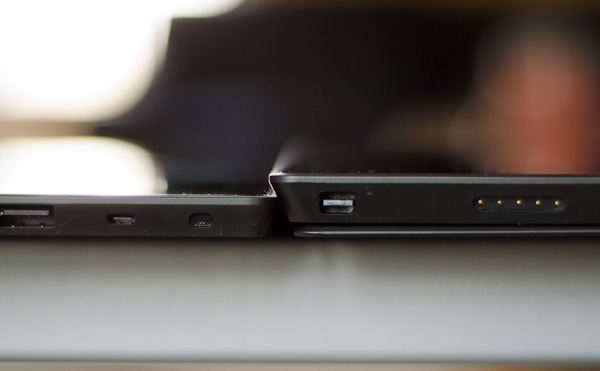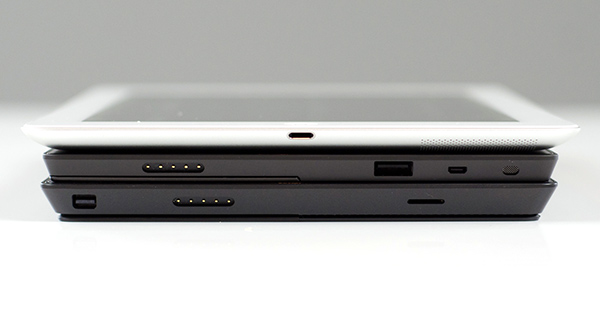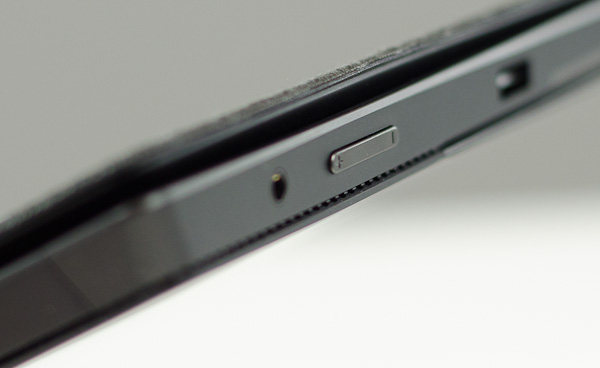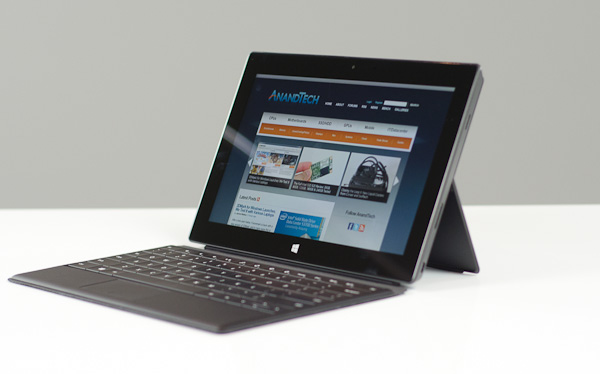Microsoft Surface Pro Review
by Anand Lal Shimpi on February 5, 2013 9:00 PM ESTSurface Pro Design
When I first saw Surface Pro, the Microsoft rep giving me the demo did a simple test. He stood Surface Pro right next to Surface, with the same start screen, and asked me if I could tell the two apart. The planar dimensions of Surface Pro are identical to Surface RT. Both feature the same sized 10.6-inch display, the same capacitive Windows button and the same 1-inch border around the screen. Looking head on, the only way you can tell the difference between Surface Pro and RT is the former’s 1080p display does make text a bit sharper.

Surface RT (left) vs Surface Pro (right)
Turn the two tablets to the side and the differences quickly become evident. Surface Pro is over 40% thicker than Surface RT (13.7mm vs 9.3mm). While the latter was of a similar thickness to an iPad with Retina Display, Surface Pro is clearly in a different league of dimensions.
The thickness of Surface Pro doesn’t really impede its portability, but the weight definitely makes it a lot less pleasant to carry around. Surface RT was already heavier than the competition but it hid its weight well. Surface Pro is just heavy for a tablet. I wasn’t originally impressed by the Surface RT form factor, but in switching between the RT and Pro models I immediately wish that Surface Pro came in the RT chassis and Surface RT came in something even thinner and lighter.

Surface Pro (left) vs. iPad 4 (right)

From top to bottom: iPad 4, Surface RT and Surface Pro
Shift the comparison to Ultrabooks however and all of the sudden Surface Pro seems quite light. It’s lighter than an 11-inch MacBook Air and Acer’s 11.6-inch Aspire S7 (although with optional keyboard cover it is heavier). It’s all about perspective. Compared to an iPad, Surface Pro is heavy, but compared to an Ultrabook or MacBook Air it’s light. The Pro model embodies the vision Microsoft had for the Surface family: to create a new type of device somewhere between a tablet and a notebook. That’s not to say there’s not room for improvement in the physical department. Surface Pro will likely go on a diet as it’s given more power efficient silicon, but even then you’ll always be able to build something thinner and lighter based on slower hardware, or go thicker and heavier with a notebook.
The fit and finish of Surface Pro are just as good as Surface RT. The tablet is built out of the same injection moulded Magnesium process (VaporMg) as Surface RT, however the chassis itself is somewhat simplified. While Surface RT featured three discrete VaporMg components (frame, back and kickstand), Surface Pro is made up of only two (single piece frame+back and kickstand). The result is no different to the end user, but the simplification on the assembly side is likely better for Microsoft.
I am fine laying the same praise on Surface Pro’s build quality as I did on Surface RT. The unique finish doesn’t feel like the aluminum we’re used to seeing on iPads, and definitely feels better than the plastic we’ve seen elsewhere. The VaporMg surface doesn’t feel like it would scratch easily, and after a few months with Surface RT I don’t see any visible scratches on my unit.
Surface Pro’s construction feels more utilitarian and understandably more oriented towards productivity, just like its little brother. I still believe that the Surface lineup is as much about Microsoft showing that it too can build high quality devices as it is about getting into the tablet market. If we compare it to the iPad, Surface Pro feels just as well built, if we compare it to every Windows RT and Windows 8 tablet or notebook on the market today - it’s worlds better. Say what you will about Microsoft entering the PC hardware business, but as of today Microsoft builds the best Windows RT and Windows 8 hardware on the market. If I ran a PC OEM I wouldn’t be angry at Microsoft, I’d be angry at myself for letting this happen.
Surface Pro retains the integrated kickstand from Surface RT, although the kickstand has been beefed up to accommodate the heavier tablet. Surface Pro’s kickstand keeps the device propped up at a fixed angle of 26-degrees away from the vertical axis. The rear facing camera is also angled to compensate (it shoots parallel to the ground with the kickstand opened).
The kickstand is allegedly good for over a million open/close cycles and it still doesn’t feel like something that would break. There are only two hinges in the kickstand compared to three for the RT model.
The kickstand on Surface Pro feels different than the kickstand on Suface RT. The Pro kickstand feels lighter and sounds less like metal and more like plastic if you tap on it. Feel around on the underside of the kickstand and you’ll notice a coating that seems to dampen sound and perhaps add some structure reinforcement to the design. Microsoft had to thicken the kickstand to support the added weight of the Surface Pro, but the difference is on the order of a fraction of a millimeter.
The tweaked kickstand does have different acoustics than Surface RT’s kickstand. While the latter sounded a lot like a thin metal door shutting, the Pro’s kickstand is far more muffled. I’d almost say it’s preferable.
Thankfully the kickstand’s functionality hasn’t been marginalized in the transition to the Pro. It’s still a highly integrated and very important part of the Surface experience. It’s simple to flip out and perfect for use on desks. You can make the kickstand work on your lap or chest if you’re lying down, but it’s not ideal for either unfortunately.
The more I use Surface (Pro and RT) the more I feel that Microsoft needs to pursue something a bit more flexible than the fixed 26-degree kickstand. The biggest issue by far is in-lap use with one of the keyboard covers attached. Depending on your seating position, the 26-degree angle that the kickstand opens at might be too small. Mechanically I don’t know the right solution for Microsoft but I do feel like for the kickstand to realize its true potential, it needs to be able to open and hold at multiple angles. It doesn’t necessarily need to have support for infinite angles, maybe even a few would work, but I do believe it’s necessary going forward.













228 Comments
View All Comments
netmann - Thursday, February 7, 2013 - link
Nice review Anand! It seems there is a lot of interest on this device. If you still have the unit can you please do a quick tear-down of the unit with pictures showing the cooling fans, SSD, memory, etc?Wolfpup - Thursday, February 7, 2013 - link
Fantastic review!Random thought I've had about Surface since it was unveiled...doesn't a keyboard dock like what HP includes with their Envy x2 make more sense than these touch/type covers?
I mean I get that some people use covers anyway, and leave them on (I don't on my iPad 2), and so you're sort of getting a keyboard always there for "free" for those people.
But at least judging by pictures, the touch and even type covers appear to be terrible keyboards, and look really awkward. The kickstand is nifty, I guess, but HP's Envy x2 (and some others) are basically giving you a normal notebook keyboard you plug it into, and it becomes almost indistinguishable from a notebook. That gives you a better keyboard, unlimited angles to put the screen at, and also makes it easier to sit it on your lap and type, if need be.
I haven't used either type of device yet, but from pictures it sure seems like a dock like that would be preferable to a type cover/pad?
This really is an interesting product though...I thought Apple needed to do this 4 years ago, like in place of what the iPad turned out to be, I was hoping it would be a real OS X PC running on Atom with an optional touch interface-basically exactly what Windows 8 ended up being.
I know these will get massively better even later this year with Haswell (or heck, Tegra 4), but I'm still so tempted both by Surface Pro and that Envy x2... (wish that used AMD's Z60 instead of Atom though). Hmm...an additional battery in a keyboard dock could double Surface Pro's battery life too...
And yeah, to me it seems like this ought to come with a type cover. I can understand and accept the price-this is an actual PC running hardware that runs circles around an iPad that's only marginally cheaper-but somehow it just seems like these things should be including keyboards.
TidalWaveOne - Thursday, February 7, 2013 - link
"f you’re shopping for an Ultrabook today and want that tablet experience as well, Surface Pro really is the best and only choice on the market."There is at least one other device for that ultrabook/tablet experience... the Dell XPS 12. I have one on order... there are also more, like the Lenovo Yoga.
Death666Angel - Thursday, February 7, 2013 - link
Different designs in my opinion. The Dell has the burden of always carrying around that keyboard, which means you have a 1.5kg tablet. The CPU, RAM and storage options look pretty good on that. But it lacks a digitizer which might or might not be a huge deal for you. Same thing with the Yoga. Very big (13.3"), low-ish resolution (900p), always a keyboard attatched, no active digitizer. Again, these things might be important enough to make the devices pretty much distinct categories. Or you just want "laptop-ish, touch screen, Core CPU" then they are all comparable. :DThe closest things to the Surface Pro in my mind are:
- Lenovo Helix: 11.6", 1080p, keyboard dock, active digitizer, 3G
- Samsung Ativ PC Pro: 11.6", 1080p, keyboard dock without battery, active digitizer, 3G
With the Lenovo being my dream device, because of the battery built into the keyboard dock mostly. But the dock design is fairly cool, too. :D
travelster - Thursday, February 7, 2013 - link
Almost two years ago I picked up an ASUS EP121 10 inch Tablet. It came with an i5 processor and Windows 7. I now have Windows 8 on it. Win 7 and 8 runs extremely well, as does Word, MS Project, VMWare, RDP, and all other apps I can run on Windows desktops and laptops. I.e. The Surface Pro's grand vision of a full-service Windows tablet was old news even before long it was released!Glenn Rogers
DBGallery Product Manager
sn_85 - Thursday, February 7, 2013 - link
After playing around with this at the Microsoft Store today I came away feel like it was a mixed bag. I feel the build quality is really impressive and I have no qualms about the unusual nature of it's kickstand and keyboard covers. It just feels like a wonderfully solid design that takes on a more business like approach with it's VaporMg and straight line design. Honestly I just wish it came in the form factor of the Surface RT because what a difference a half pound and 3.5mm can really make. The thick form factor and weight just make it much more cumbersome to hold and I wouldn't see myself holding this thing in one for two long at all. Before anyone calls me a weight weenie you really just have to hold it in person and compare the Pro the RT before make a statement, it's a pretty significant difference. I hope the next iteration takes on a diet and comes closer to the form factor of the Surface RT because it still retains the impressive build quality without all the thickness and weight.Battery of course is another area of concern. If this thing got closer to 6-7 hours like some of the longer lasting Ultrabooks it would be a real winner IMO.
The price I feel is fine but the keyboard covers need to be included in the price. I know it's a unique design but there is no reason for MSFT to be nickel and diming here, especially in the case of the Pro. Fact is anyone looking at this device will buy either one of the Touch or Typecovers but to just spend another $120-$130 on it is excessive.
Ultimately I think this device is what most reviews say, you can see the tremendous potential and it is impressive in it's own right. It just misses on a few key things that keep it from being a product that is universally recommended as opposed to what it is right now where you need to know what you're getting into. I feel just like Anand on this, the Surface Pro 2 is simply going to be an awesome product. One that I'd buy on launch day. That being said I still might get this Surface Pro until that time comes.
sirnumbskull@gmail.com - Friday, February 8, 2013 - link
Can you verify whether or not the Surface Pro has Widi support?Kornfeld - Friday, February 8, 2013 - link
WiDi is an Intel technology that requires, among other things, supported Intel WiFi adapters. Since Surface Pro uses a Marvell WiFi adapter, it cannot possibly use WiDi.The real question is whether it will support Miracast which is the larger spec being adopted by the WiFi alliance. I'm not sure if that specific adapter supports Miracast. I found this press release, but I'm not sure about the part numbers: http://www.marvell.com/company/news/pressDetail.do...
The bigger problem with Miracast right now is that there doesn't seem to be any connection software available for Windows. So, I'm sitting around with a Yoga that has a Miracast supported WiFi adapter and I have the latest Netgear device that supports WiDi and Miracast, but no application that can be used to connect to the device.
toyotabedzrock - Friday, February 8, 2013 - link
Looking at the pictures it becomes apparent that they did not pay enough attention to small details. The random 5 pin connector looks ripe for problems. And sticks out like a soar thumb.The display resolution is too low on both models. And there is no excuse for the small batteries.
It seems as if the execs at these PC companies eyes are failing them if they have not noticed these things.
redSn0w - Friday, February 8, 2013 - link
Just wondering if Microsoft could have gotten better battery life by using a Core i3 or even some pentium/celeron derivative. The way i see it, the 3 main drawbacks are the price, battery life and thickness/weight of device. So, maybe using one of the aforementioned processors for the first generation product would have helped. And, they could have moved to Core i5 when Haswell started shipping.I seriously doubt that any power user could replace their notebook/desktop with a Surface pro unless you could dock it to a bigger screen and a proper keyboard. As for the regular users i don't think too many of them would even be interested in a product like this when an iPad works for them.
Anyways, i'm still going to go check it out tomorrow but most likely i'll wait for the next generation product (if it's ever released).